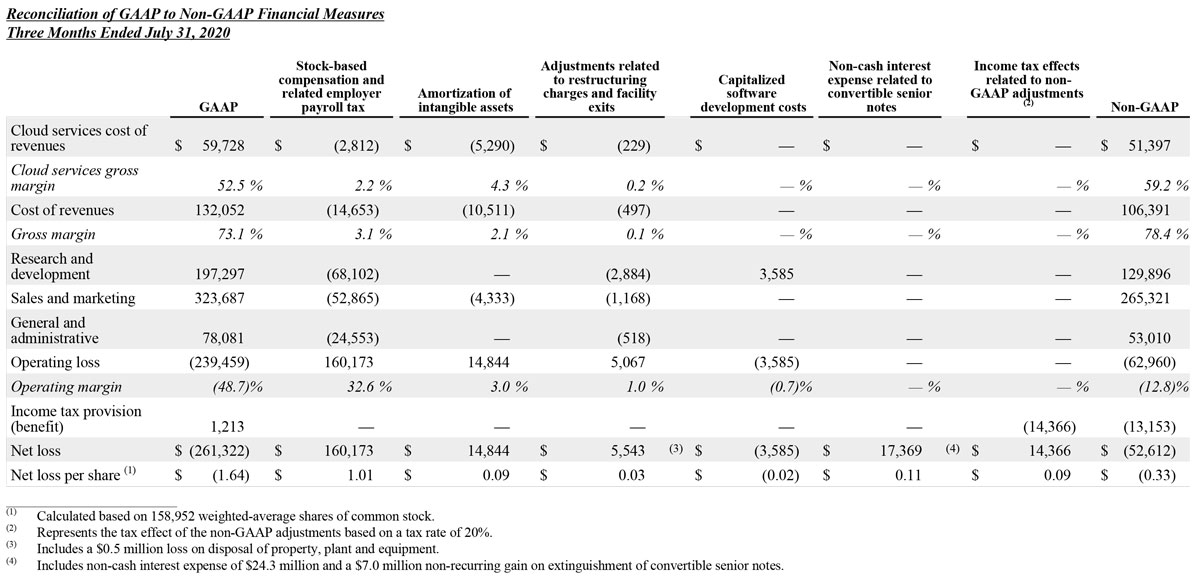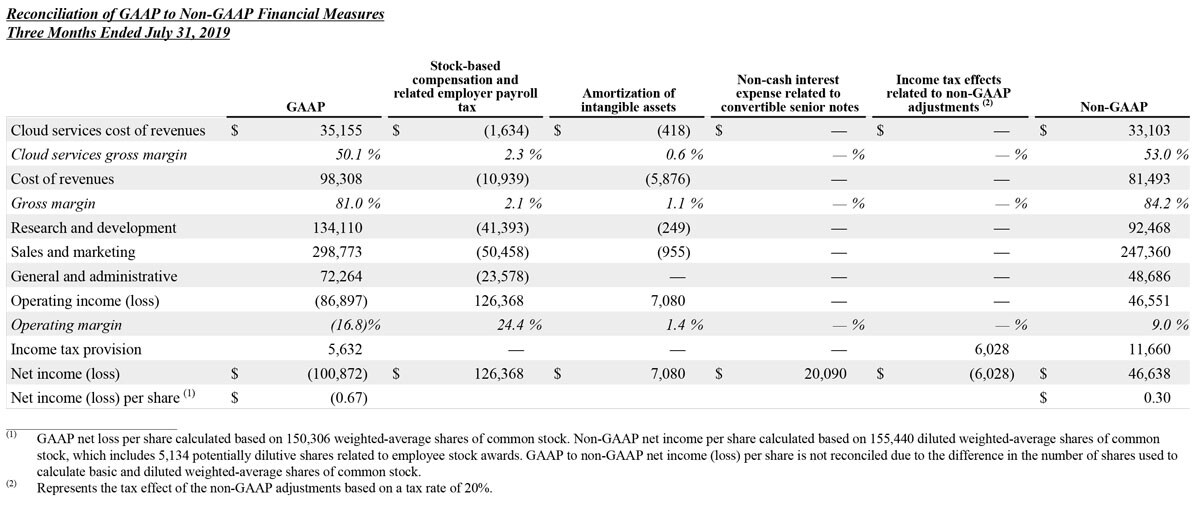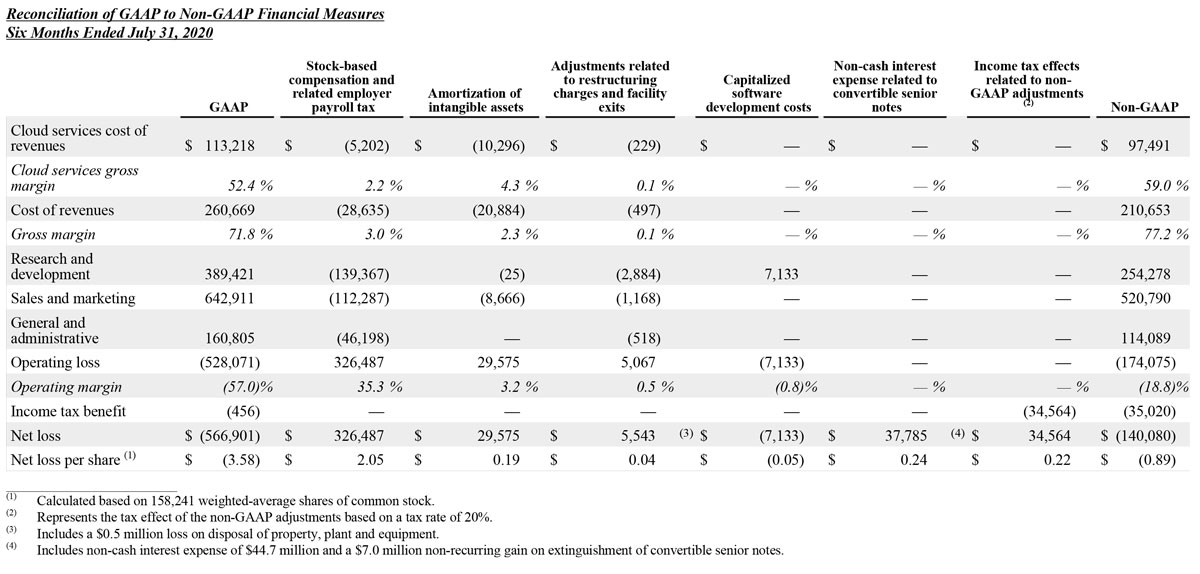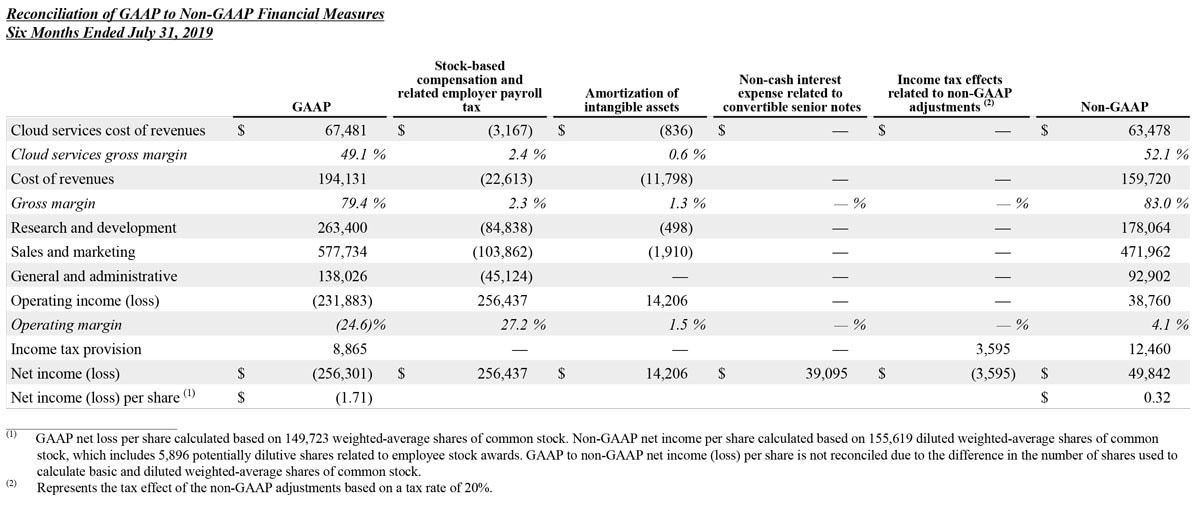SAN FRANCISCO – August 26, 2020 – Splunk Inc. (NASDAQ: SPLK), provider of the Data-to-Everything Platform, today announced results for its fiscal second quarter ended July 31, 2020.
Second Quarter 2021 Financial Highlights
- Cloud ARR was $568 million, up 89% year-over-year.
- Total ARR was $1.93 billion, up 50% year-over-year.
- Cloud revenue was $126 million, up 79% year-over-year.
- Total revenues were $492 million, down 5% year-over-year.
- 396 customers with ARR greater than $1 million.
“As organizations continue to adapt to tectonic societal shifts brought on by COVID-19, one thing is constant: the power of data to radically transform business,” said Doug Merritt, President and CEO, Splunk. “I’m pleased to see the role Splunk’s Data-to-Everything platform has played in helping our customers drive meaningful insights as they advance into The Data Age to meet the challenges of 2020 and beyond.”
“Splunk’s cloud business continues to accelerate, now representing more than half of our software bookings in the quarter - a major milestone in our cloud journey,” Merritt continued. “I’m very proud of our team, strong execution and continued momentum as we look forward to revealing our line-up of trendsetting product innovations at .conf20.”
“Splunk’s rapid transformation to the cloud has enabled us to reach key milestones ahead of schedule. Cloud ARR growth accelerated to 89%, or $568 Million, far exceeding our expectations. We also now have nearly 400 customers with ARR in excess of $1 million as more and more businesses embrace our cloud platform,” said Jason Child, chief financial officer, Splunk. “Our customers want the flexibility to transition to cloud, and with our diligent planning, we’ve continued to advance our mission to remove the barriers between data and action.”
Recent Business Highlights:
New and Expansion Customers Include: Atlassian (Australia), California Polytechnic State University - San Luis Obispo, Chicago Public Schools, Costco Travel, DHS Cybersecurity and Infrastructure Security Agency, Financial Industry Regulatory Authority (FINRA), Jemena (Australia), L'Oreal USA, Mars, The Motley Fool, NASA, Transport for London (United Kingdom), University of California, Irvine, United Shore, Yale New Haven Health System
- Splunk Cloud Helps Customers Thrive in The Data Age: To help customers unlock business value with data and shift to the cloud faster than ever at scale, Splunk unveiled new updates to Splunk IT Service Intelligence (ITSI). Splunk ITSI 4.5 delivers a centralized framework for monitoring and investigation in one view, giving organizations enhanced service monitoring and event management features to support large deployments. Splunk also introduced Splunk Machine Learning Toolkit (MLTK) 5.2, which offers a simplified, customizable interface that provides broader access of the tool to less technical users and removes many barriers for machine learning exploration.
- Data Stream Processor Strengthens IT, Security and DevOps Capabilities: An explosion of data volume coming from new sources is leaving organizations with more data than they ever imagined. To help give customers more control, visibility and insights into their data, Splunk released the latest version of Splunk Data Stream Processor (DSP), a real-time stream processing solution that continuously collects, processes and delivers data to the Splunk platform or other destinations within milliseconds. Splunk DSP 1.1 gives organizations the ability to collect data into a single unified location for better visibility and leverage advanced streaming capabilities.
- Splunk Customers Can Take Action on Data Anywhere with Splunk Connected Experiences: COVID-19 has created a global tele-workforce and with it, a greater need for customers to act on their data from anywhere in the world. New updates to Splunk Connected Experiences now support popular mobile device management (MDM) providers, allowing customers to securely deploy Splunk Mobile at scale.
- Splunk Enables Organizations to Navigate the Global Restart with Confidence: Splunk continues to support customers, partners, employees and communities during the COVID-19 pandemic. In addition to releasing Remote Work Insights, a free, downloadable solution which gives organizations real-time visibility on critical business activities across disparate systems, Splunk unveiled its Global Restart program, showcasing how data will help the world get back to work. Visit the Splunk website to learn more about how organizations can bring data to their COVID-19 response and build a more resilient workforce with data.
- .conf20 is Free...and in Your Living Room: Splunk’s annual user conference, .conf20, is going virtual. Taking place across October 20-22, .conf20 is the premier education event for thousands of IT, security and business professionals looking to bring data to every question, decision and action. To register and learn more about .conf20 and the nearly 200 sessions you can access free from your own home, visit the Splunk website.
- Splunk Ranks #1 in IDC’s IT Operations Management Market For Second Year in a Row: Leading industry analyst firm IDC ranked Splunk No. 1 for 2019 market share and market revenue in their latest report: Worldwide IT Operations Management Software Market Shares, 2019. With 13% market share of the ITOM market, IDC evaluated Splunk’s IT offerings including Splunk IT Service Intelligence, Splunk App for Infrastructure, Splunk Cloud, SignalFx Infrastructure Monitoring and SignalFx Microservices APM.
Financial Outlook
The company is providing the following guidance for its fiscal third quarter 2021 (ending October 31, 2020):
- Total revenues are expected to be between $600 million and $630 million.
- Non-GAAP operating margin is expected to be between 2% and 5%.
All forward-looking non-GAAP financial measures contained in this section “Financial Outlook” exclude estimates for stock-based compensation and related employer payroll tax, acquisition-related adjustments, amortization of intangible assets and capitalized software costs.
A reconciliation of non-GAAP guidance measures to corresponding GAAP measures is not available on a forward-looking basis without unreasonable effort due to the uncertainty regarding, and the potential variability of, many of these costs and expenses that may be incurred in the future. The company has provided a reconciliation of GAAP to non-GAAP financial measures in the financial statement tables for its fiscal second quarter 2021 non-GAAP results included in this press release.
Conference Call and Webcast
Splunk’s executive management team will host a conference call today beginning at 1:30 p.m. PT (4:30 p.m. ET) to discuss the company’s financial results and business highlights. Interested parties may access the call by dialing (866) 501-1535. International parties may access the call by dialing (216) 672-5582. A live audio webcast of the conference call will be available through Splunk’s Investor Relations website at http://investors.splunk.com/events-presentations. A replay of the call will be available through September 2, 2020 by dialing (855) 859-2056 and referencing Conference ID 6881816.
Safe Harbor Statement
This press release contains forward-looking statements that involve risks and uncertainties, including statements regarding Splunk’s revenue and non-GAAP operating margin targets for the company’s fiscal third quarter in the paragraphs under “Financial Outlook” above and other statements regarding our market opportunity, including the impact of the COVID-19 pandemic on the business environment, such as the pace of customer digital transformation and the importance of data; the market for data-related products and trends in this market, future growth and related targets, including trends in our cloud software business mix, momentum, growth rate, strategy, technology and product innovation; expectations for our industry and business, such as our business model, customer demand, our partner relationships, customer success and feedback, expanding use of Splunk by customers, and expected benefits and scale of our products. There are a significant number of factors that could cause actual results to differ materially from statements made in this press release, including: risks associated with Splunk’s rapid growth, particularly outside of the United States; Splunk’s inability to realize value from its significant investments in its business, including product and service innovations and through acquisitions; Splunk’s shift from sales of perpetual licenses in favor of sales of term licenses and subscription agreements for our cloud services which impact the timing of revenue, cash collections and margins; Splunk’s transition to a multi-product software and services business; Splunk’s inability to successfully integrate acquired businesses and technologies; Splunk’s inability to service its debt obligations or other adverse effects related to our convertible notes; the impact of the COVID-19 pandemic and related public health measures on our business, as well as the impact of the COVID-19 pandemic on the overall economic environment; and general market, political, economic, business and competitive market conditions.
Additional information on potential factors that could affect Splunk’s financial results is included in the company’s Quarterly Report on Form 10-Q for the fiscal quarter ended April 31, 2020, which is on file with the U.S. Securities and Exchange Commission (“SEC”) and Splunk’s other filings with the SEC. Splunk does not assume any obligation to update the forward-looking statements provided to reflect events that occur or circumstances that exist after the date on which they were made.
About Splunk Inc.
Splunk Inc. (NASDAQ: SPLK) turns data into doing with the Data-to-Everything Platform. Splunk technology is designed to investigate, monitor, analyze and act on data at any scale.
Splunk, Splunk>, Data-to-Everything, D2E and Turn Data Into Doing are trademarks and registered trademarks of Splunk Inc. in the United States and other countries. All other brand names, product names, or trademarks belong to their respective owners. © 2020 Splunk Inc. All rights reserved.
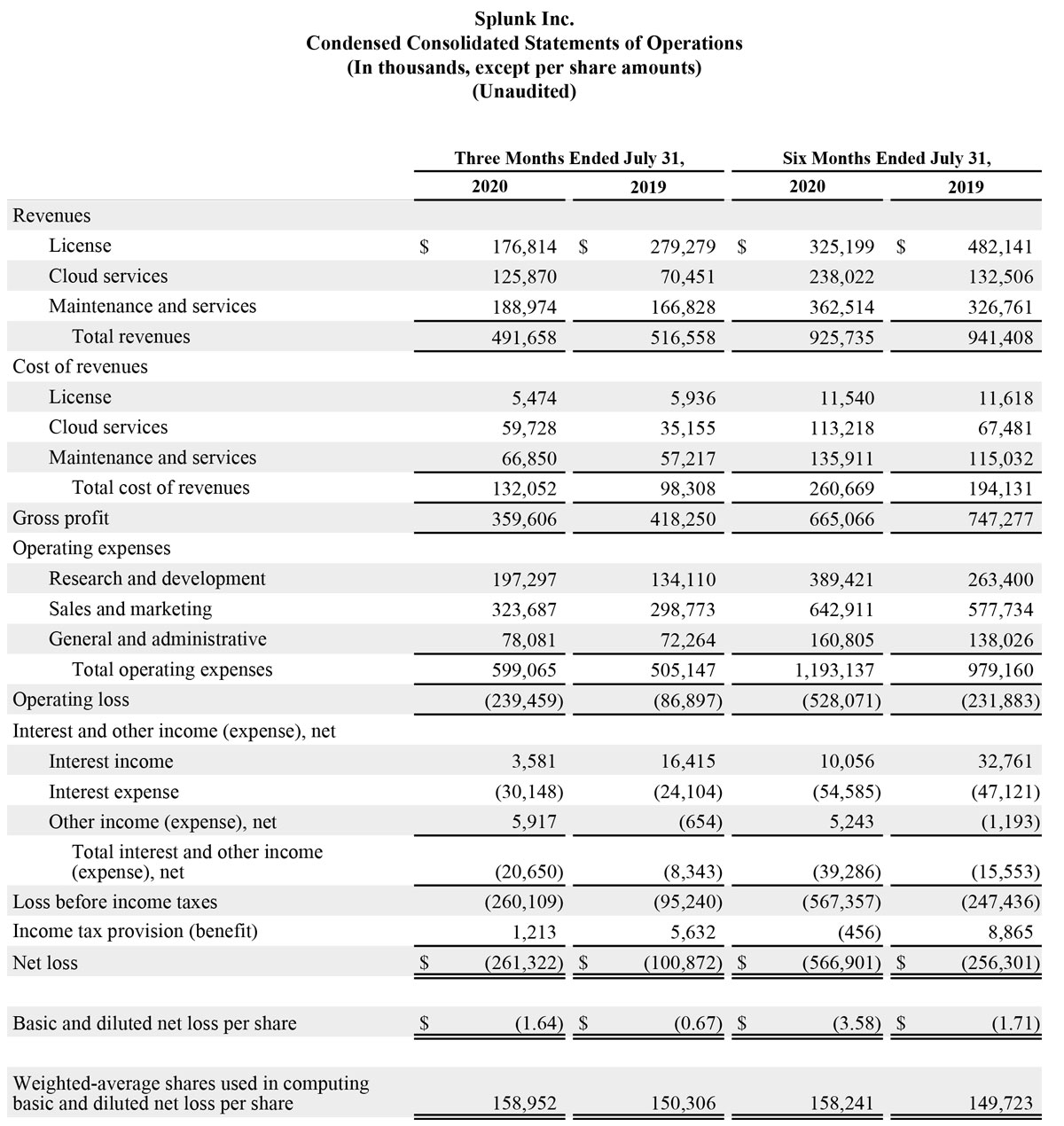
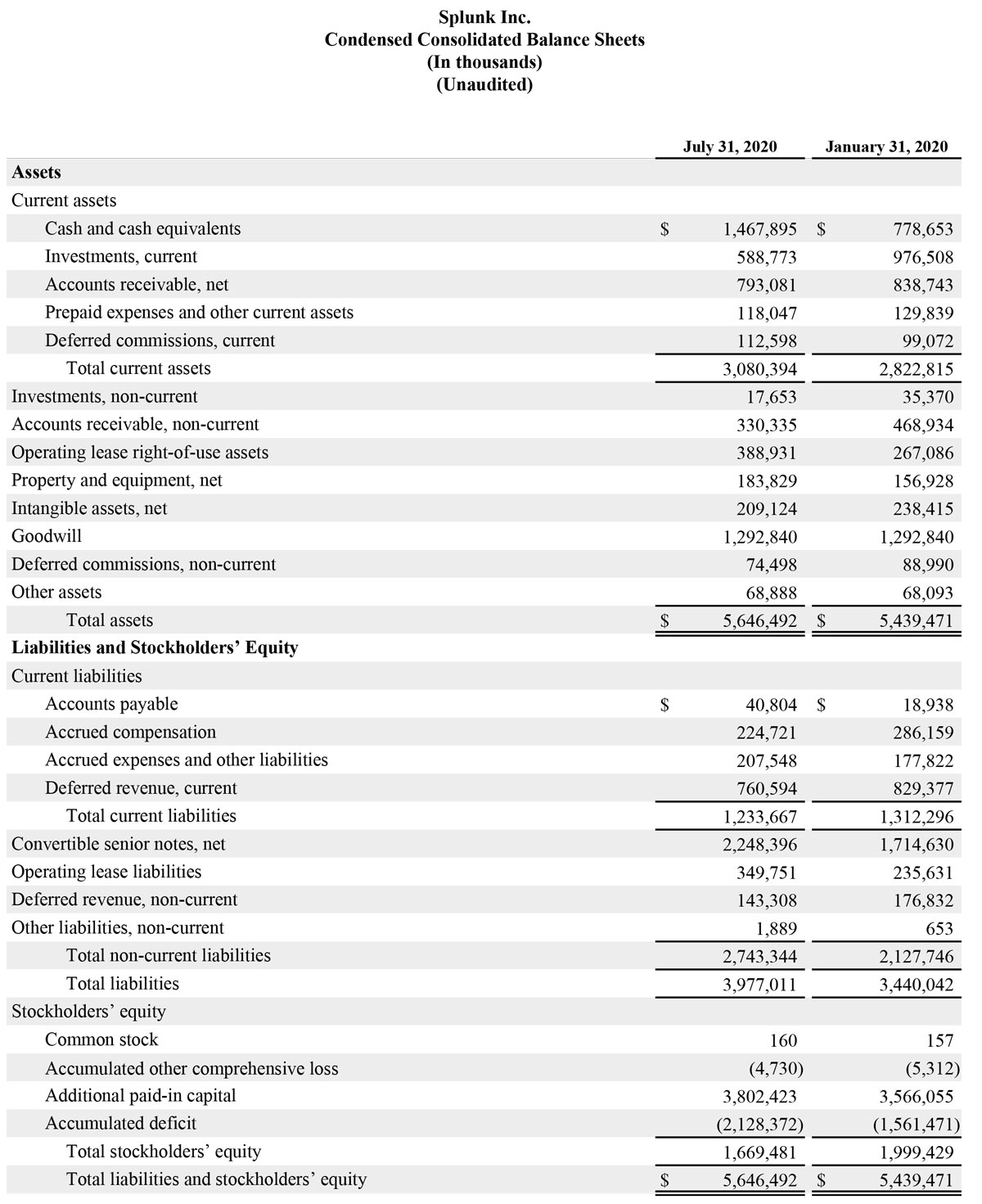
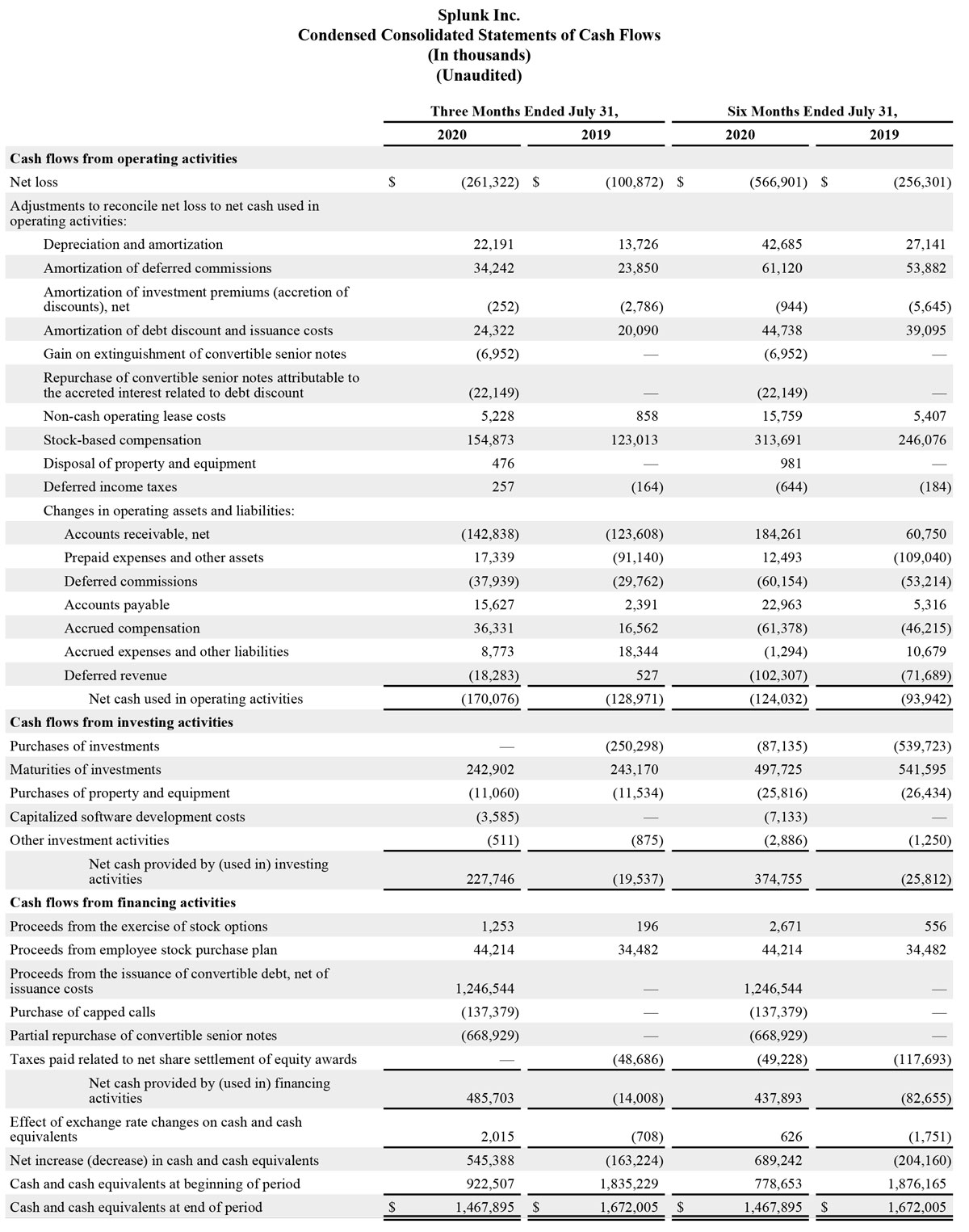
Splunk Inc.
Operating Metrics
Total Annual Recurring Revenue (“Total ARR”) represents the annualized revenue run-rate of active subscription, term license, and maintenance contracts at the end of a reporting period. Cloud Annual Recurring Revenue (“Cloud ARR”) represents the annualized revenue run-rate of active subscription contracts at the end of a reporting period. Contracts are annualized by dividing the total contract value by the number of days in the contract term and then multiplying by 365.
Non-GAAP Financial Measures and Reconciliations
To supplement Splunk’s condensed consolidated financial statements, which are prepared and presented in accordance with generally accepted accounting principles in the United States (“GAAP”), Splunk provides investors with the following non-GAAP financial measures: cloud services, cost of revenues, cloud services gross margin, cost of revenues, gross margin, research and development expense, sales and marketing expense, general and administrative expense, operating income (loss), operating margin, income tax provision (benefit), net income (loss), net income (loss) per share and free cash flow (collectively the “non-GAAP financial measures”). These non-GAAP financial measures exclude all or a combination of the following (as reflected in the following reconciliation tables): expenses related to stock-based compensation and related employer payroll tax, amortization of intangible assets, adjustments related to restructuring charges and facility exits, capitalized software development costs, non-cash interest expense related to convertible senior notes and a gain on extinguishment of convertible senior notes. The non-GAAP financial measures are also adjusted for Splunk's estimated tax rate on non-GAAP income (loss). To determine the estimated non-GAAP tax rate, Splunk evaluates financial projections based on its non-GAAP results and the tax effect of those projections. The estimated non-GAAP tax rate takes into account many factors including operating structure, tax positions and legislation. The non-GAAP tax rate applied to the three and six months ended July 31, 2020 was 20%. Splunk provides updates to this rate as needed if material changes occur. The applicable fiscal 2020 tax rates are noted in the reconciliations. In addition, non-GAAP financial measures include free cash flow, which represents operating cash flow less purchases of property and equipment. Splunk considers free cash flow to be a liquidity measure that provides useful information to management and investors about the amount of cash generated or used by the business.
Splunk excludes stock-based compensation expense because it is non-cash in nature and excluding this expense provides meaningful supplemental information regarding Splunk’s operational performance and allows investors the ability to make more meaningful comparisons between Splunk’s operating results and those of other companies. Splunk excludes employer payroll tax expense related to employee stock plans in order for investors to see the full effect that excluding that stock-based compensation expense had on Splunk’s operating results. These expenses are tied to the exercise or vesting of underlying equity awards and the price of Splunk’s common stock at the time of vesting or exercise, which may vary from period to period independent of the operating performance of Splunk’s business. Splunk also excludes amortization of intangible assets, adjustments related to restructuring charges and facility exits, capitalized software development costs, non-cash interest expense related to convertible senior notes and a gain on extinguishment of convertible senior notes from the applicable non-GAAP financial measures because these adjustments are considered by management to be outside of Splunk’s core operating results.
There are limitations in using non-GAAP financial measures because the non-GAAP financial measures are not prepared in accordance with GAAP, may be different from non-GAAP financial measures used by Splunk’s competitors and exclude expenses that may have a material impact upon Splunk’s reported financial results. Further, stock-based compensation expense has been and will continue to be, for the foreseeable future, a significant recurring expense in Splunk’s business and an important part of the compensation provided to Splunk’s employees. The presentation of the non-GAAP financial measures is not intended to be considered in isolation or as a substitute for, or superior to, the financial information prepared and presented in accordance with GAAP. Splunk uses these non-GAAP financial measures for financial and operational decision-making purposes and as a means to evaluate period-to-period comparisons. Splunk believes that these non-GAAP financial measures provide useful information about Splunk’s operating results, enhance the overall understanding of past financial performance and future prospects and allow for greater transparency with respect to key metrics used by management in its financial and operational decision making. In addition, these non-GAAP financial measures facilitate comparisons to competitors’ operating results. The non-GAAP financial measures are meant to supplement and be viewed in conjunction with GAAP financial measures.
The following tables reconcile Splunk’s GAAP results to Splunk’s non-GAAP results included in this press release.

